11 Best Gym Exercises For Runners

Should Runners Lift Weights?
With new research emerging each month on the health and longevity benefits of resistance training, as well as the rise of hybrid training, I think we all know by now that lifting weights isn’t just for meat heads looking to bulk up; it’s a game-changer for runners too. If you’re logging miles without hitting the weights, you’re leaving serious performance gains on the table. Here’s the rub: resistance training builds strength, and strength means power and durability. When you strengthen key running muscles — glutes, hamstrings, quads, and calves—you’re not just adding slabs of muscle but forging bulletproof joints and tendons that can push you harder, for longer. The result? A more efficient stride, more powerful takeoffs, fewer injuries, and stronger finishes.
The Benefits of Lifting Weights For Runners
A stronger body can handle more running volume and intensity without breaking down. Less fatigue and stronger joints and supporting muscles means a reduced chance of injury. Many runners suffer from overuse injuries like shin splints and runner’s knee, which could stem from muscle imbalances and weaknesses. Resistance training addresses these issues by creating a solid foundation. When your muscles are balanced and your 'structure’ is strong, your form stays solid as fatigue sets in, the exact time when injuries are likely to strike.
But it’s not just about injury prevention. Studies have shown that lifting weights increases bone density, which is crucial for longevity in a sport where impact is a constant. You’re not just protecting yourself; you’re building a body that can go the distance — literally. Plus, there’s the often overlooked metabolic benefit: muscle burns more calories at rest than fat. So, you’re not just faster and more resilient; you’re leaner and more efficient.
Think of resistance training as the secret sauce to your running recipe. It’s not about becoming a bodybuilder but becoming an all-around athlete. If you want to hit a new PR, finish your races strong, and keep pounding the pavement injury-free, it’s time to make friends with the iron. Your future self will thank you.
To that end, we’ve lined up 11 of the best movements for you to integrate into your gym routine. Lace up, and let’s get stuck in.
The 11 Best Gym Exercises For Running

Deadlifts
Whether you use a barbell, dumbbells, kettlebells, trap bar or pretty much anything you can pick up from the ground, deadlifts are a massive 'bang-for-buck' movement, working a huge number of muscles, but particularly the muscles of your posterior chain. These muscles are important for maintaining a strong posture, vital on long and short runs alike.
Form Check
Hold a pair of heavy dumbbells at your sides and with a flat back, push your glutes back, hinge down and touch your 'bells to the ground (A). Squeeze your lats and stand upright, pushing the ground away with your feet, ensuring your hips don’t shoot up too early (B). Your arms should be hanging straight throughout this movement, think of them as ropes connecting you to your dumbbells.

Split Squats
Working your lower body unilaterally (loading one leg at a time) is crucial for addressing imbalances. These left-to-right discrepancies may be small, but when you're pounding the pavement at 180 steps-per-minute, they soon add up. Split squats let you isolate and work each leg individually to weed out weaknesses.
Form Check
Stand tall with your back foot resting on a bench or box behind you, with dumbbells hanging at your sides, or held in the goblet position (A) bend at the front knee, slowly lowering until your front thigh is below parallel to the ground (B). Drive your weight through your front foot, standing back up explosively.
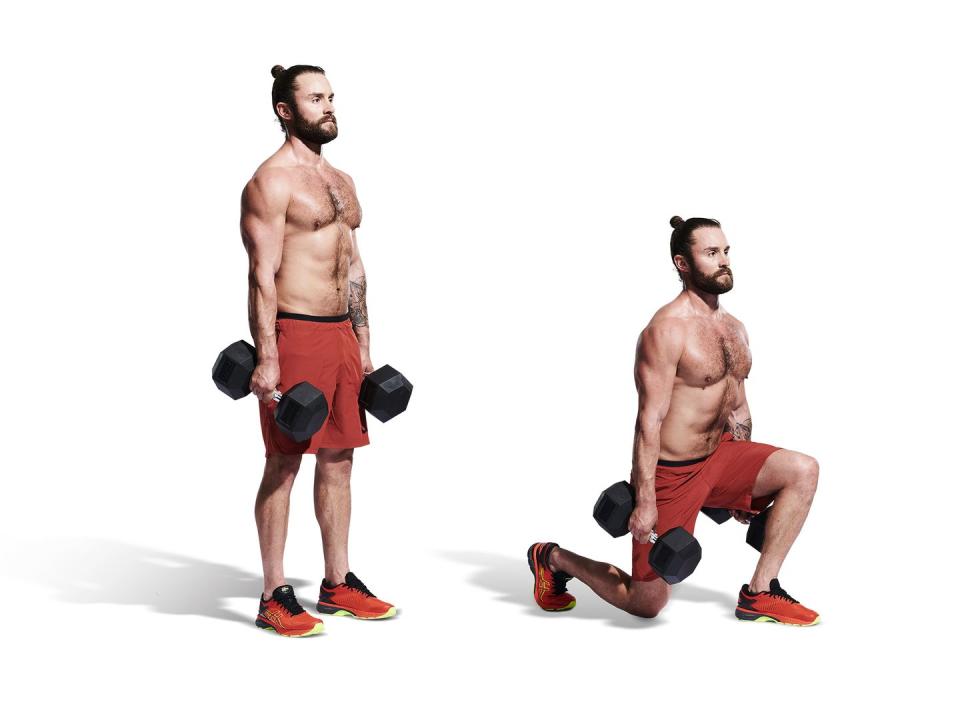
Lunges
Another unilateral movement, this time with the added benefit of moving your body through space and an additional stimulus on that all important posterior chain. Keeping your torso upright against gravity as you lunge forward also helps to build 'anti-flexion' strength, perfect for maintaining your posture as the miles wear on.
Form Check
Hold a pair of dumbbells at your waist and stand tall (A). Take a step forward with one leg, bending the at the knee until the back knee touches the ground (B). Stand up explosively, pause and repeat with the other leg.
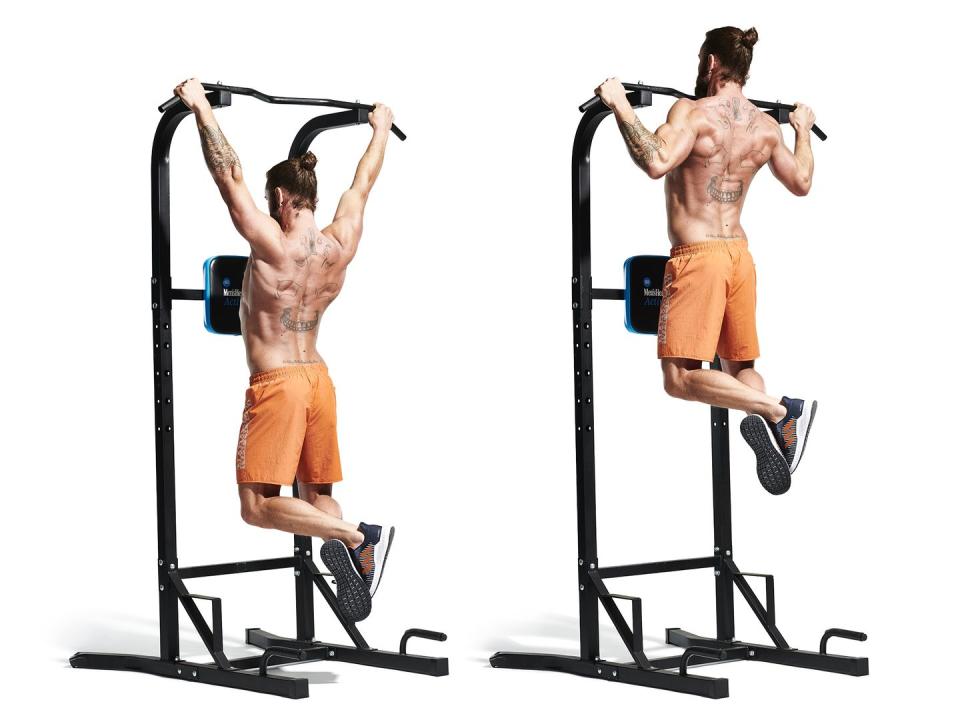
Pull-ups
Pull-ups, on a list of best exercises for runners? Really? Well, yes. Pull-ups don't just work those ever important postural muscles of the upper back, they're also super accessible: you don't need a fully kitted out gym, just something above your head to grab a hold of. If you're not interested in lifting weights, simply implementing this bodyweight GOAT into your training will give your running a boost.
Haven't quite achieved those first few pull-ups? Check out our guide here.
Form Check
Grasp a pull-up bar with an overhand grip over shoulder-width apart, lift your feet from the floor, hanging freely with straight arms. (A) Pull yourself up by flexing the elbows while pinching your shoulder blades together. When your chin passes the bar, (B) pause before lowering to the starting position.
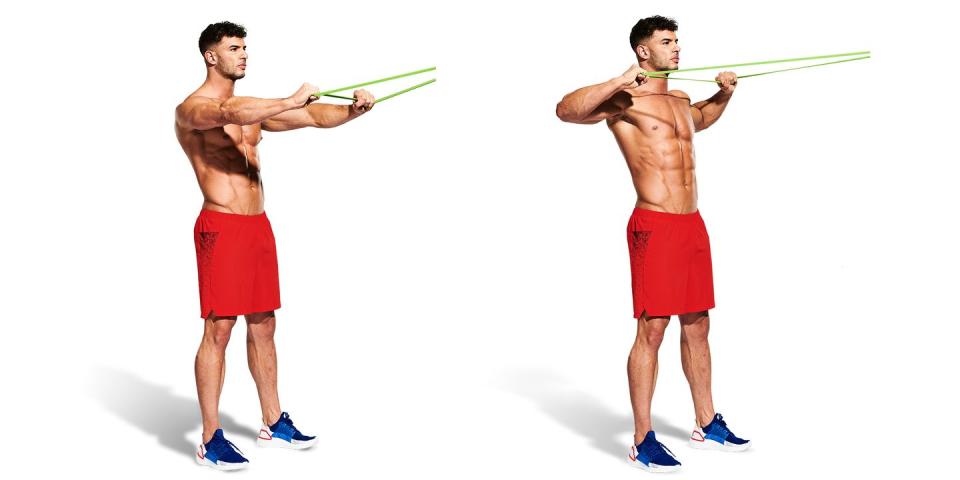
Face Pulls
Face pulls are one of the most effective movements for cultivating good shoulder-joint hygiene and working the postural muscles of the upper back. A handy movement to include in your warm-ups, between pressing movements, or on your 'off' days to increase blood flow and aid recovery.
Form Check
Set yourself up at a high-cable pulley with a rope, or with a resistance band anchored at a high point. Hold the rope or band with both hands and step back until, with straight arms, you can feel tension (A). Keeping your shoulders pressed down, drive your elbows back and pull your hands towards your face, squeezing your shoulder blades together at the top of the rep (B) Slowly reverse the movement and repeat.
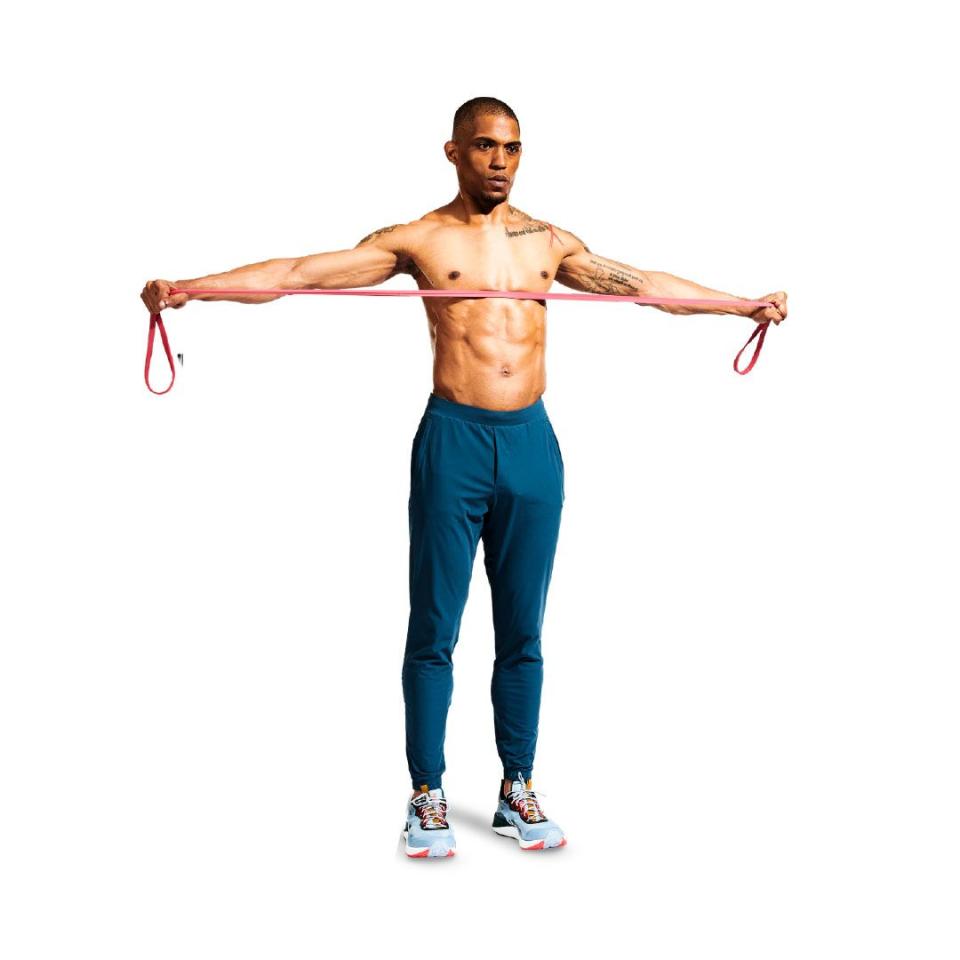
Band Pull Aparts
All of the benefits we've just described for face pulls, without the necessity of a cable machine, or somewhere to anchor your band. Simply grab your band and get to work strengthening your postural muscles and working those shoulders-joints.
Form Check
Hold a resistance band in front of your body, slightly below chest height (A). Keeping your arms straight, explosively pull the band apart, squeezing your shoulder blades together. When the band touches your chest (B), reverse the movement and repeat. Try to avoid shrugging your shoulders.

Front Squats
It should be pretty obvious why squats are on this list. They're the GOAT of lower body movements. Front squats, specifically, are a great addition into the strength training regiment of any runner. The front loading makes it easier to maintain an upright torso, your upper back comes into play to maintain a solid posture (perfect for runners) and your core is engaged for 'anti-flexion' stopping the barbell from folding you up like a pretzel. All of these benefits carryover massively to running.
Form Check
With your feet at shoulder width, hold a barbell across your chest. Then, lift your elbows high to secure the bar on your shoulders (A). Maintain an upright torso and push your hips back, bending your knees until your thighs pass parallel to the floor (B). Stand back up to the start position.
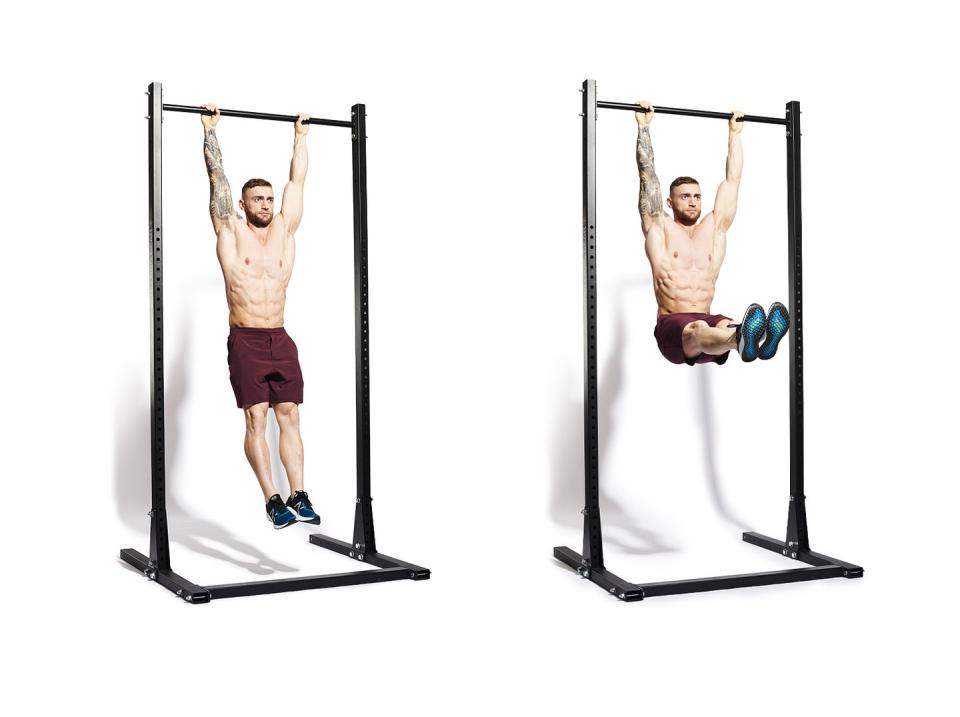
Hanging Leg Raises
The simple act of hanging from a bar has a laundry list of benefits: decompressing your spine, building shoulder strength and stability and stretching the upper body. But by adding in a hanging leg raise you'll also strengthen your hip flexors and trunk, important elements for running performances.
Form Check
Hang from a bar (A). Focussing on contracting your abs hard, slowly lift your feet into the air, keeping your legs straight until they’re parallel to the ground (B). Slowly lower your feet, but don’t let them swing back behind you. Repeat.
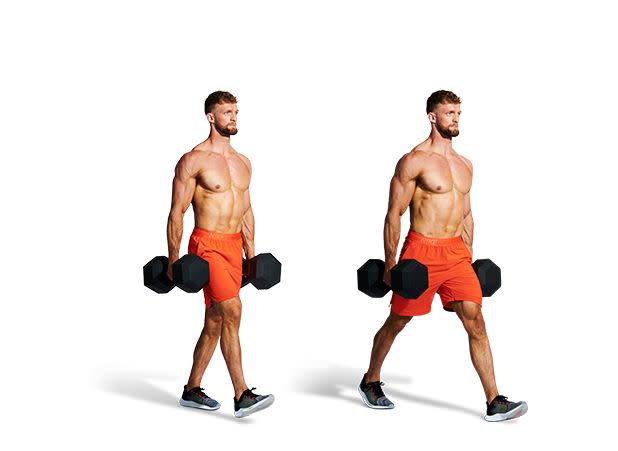
Farmers Walk
Walking with weights is great way to not just strengthen your entire body, but also to teach your body to output and maintain that strength while in motion. Heavy farmers carries will build your postural muscles, strengthen your core and, done at a suitable intensity, they'll also act to work your energy systems, boosting your fitness.
Form Check
Deadlift a pair of dumbbells, kettlebells or farmers handles up to waist height (A) Let your arms hang freely at your sides, stand tall, locking your ribcage down and begin a fast, deliberate march (B).
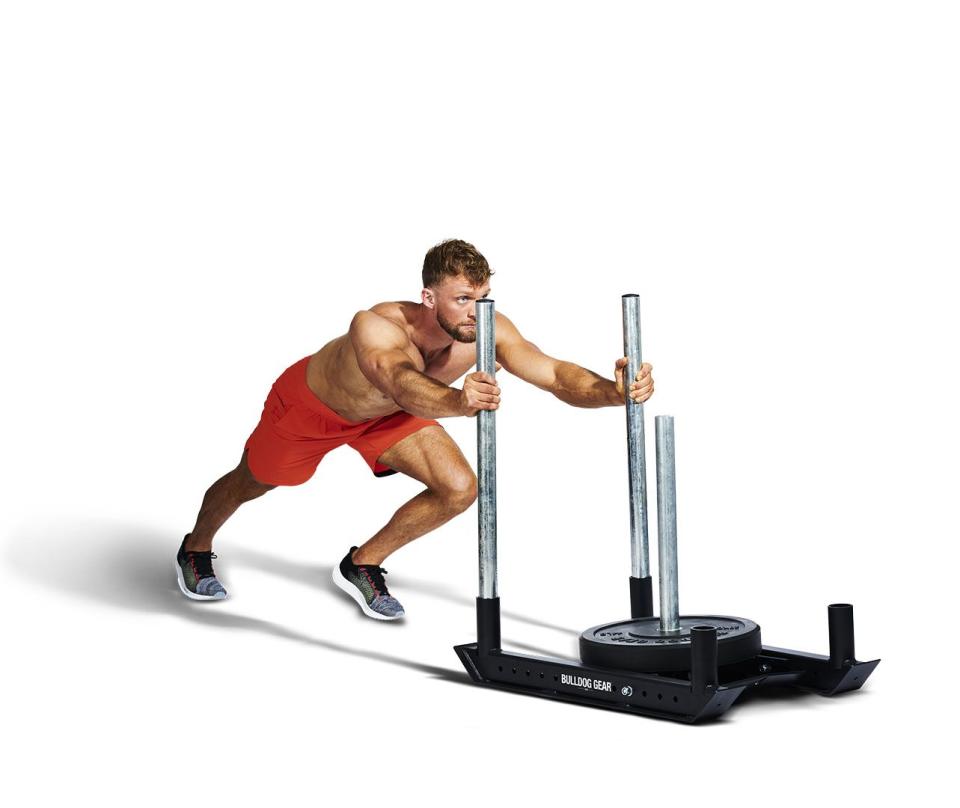
Sled Push/ Drag
Sled pushes and drags both help to build massive strength through the lower body, as well as fostering a strong structure through the upper body when pushing the sled, and may even help with knee injuries. On top of this, due to the fact that sled work lacks an 'eccentric' component (the lowering part of most lifting movements that tends to cause the most soreness in the following days), sled pushes and pulls are a great movement to integrate between running days.
Form Check
Grab the handles of a sled and lean in. Get low, with your torso almost parallel to the ground (A). Drive the sled by marching forward. As the weight creeps up, take smaller steps to generate more power (B).
For a reverse drag, hold a set of handles or attach a belt to the sled, standing facing the sled and march backwards, dragging the sled along in front your body.
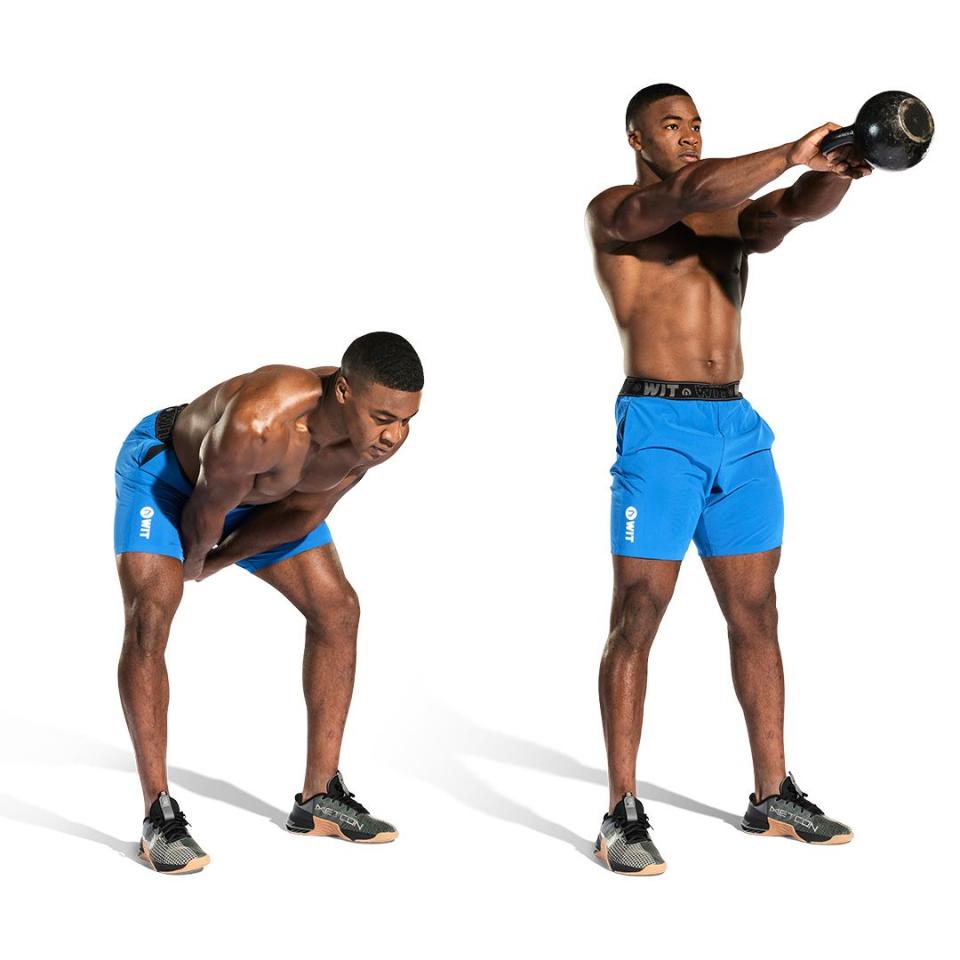
Kettlebell Swing
Just like the deadlift, the kettlebell swing is a powerhouse move for building the posterior chain. Unlike the deadlift however, you don't need to load up on the weight to make swings effective, instead your goal is to be as explosive as possible. The dynamic nature of swings helps to build the fast twitch muscles of the glutes, hips and hamstrings, perfect for sprint efforts, while also reinforcing that all important 'postural structure'.
Form Check
With a kettlebell between your legs, hinge at your hips, swinging the weight backward, high between your thighs (A). Drive your hips forward to explosively blast it up to eye level (B). Let the momentum return you back into the hinge position and then reverse straight into the next rep. Keep your torso flat and knees soft throughout.
Hybrid Run+Lift Workouts For Runners
Take Your Training Outdoors with This 1,000-Rep Hybrid Bodyweight and Running Partner Workout
This Hybrid Bodyweight Workout Promises a Bonus Sleeve Splitting Arm Pump
The Perfect Bodyweight and Sprint Workout for an Outdoor Pump in the Sun
You Might Also Like


